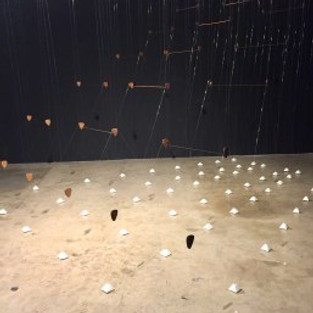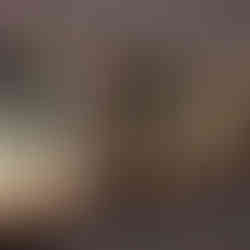Debra Scacco at Klowden Mann
- artandcakela
- Feb 1, 2018
- 4 min read

Debra Scacco, Puzzle for the Feeble-minded Photo credit: Shana Nys Dambrot
Debra Scacco: The Narrows
through February 17 Klowden Mann, Culver City
By Shana Nys Dambrot Debra Scacco is a rare presence in contemporary art — a mindfully reductive conceptualist with the emotional soul of a storyteller. As schematic abstraction goes, Scacco’s work is warm, evocative, and unusually lyrical. Her previous work has often included an element of abstract cartography, in which she has sought to express in rarefied visual quantification the sensations of land, sea, travel, and national identity. In her current exhibition at Klowden Mann, Scacco presents a self-contained tripartite project which evolves from these earlier series in both form and content. The Narrows is the name of the strait between Brooklyn and Staten Island. It’s where the Statue of Liberty is and. therefore, where between 1892-1954 some 12 million people, including members of Scacco’s own family, arrived in America. A suite of small-scale glass etchings, a sculptural installation, and a video all interact in a project derived directly from stories of Ellis Island and its symbolic and literal, historical and geographical, framing of the journeys of American immigration, investigating and visualizing what the artist calls, “institutional structures of permission.”
In perhaps the most literal materialization of this premise, Scacco produces an architecturally scaled depiction of a three-well staircase that was commonly and poignantly called the Stairs of Separation — a bureaucratic location at the arrival/screening center, from the bottom of which you would anxiously learn your fate. You either went ahead into America, remained in limbo on the island, or immediately returned to your point of origin. Architecture of Separation (2018, teak plywood, concrete, embroidery thread, fishing wire, hardware, 12 x 12 x 9.5 feet), is a ghost in the space, a faintly glistening, counterweighted web more than an object, a bit of an obstacle course. Its outlines can be glimpsed in caught light, best viewed by a viewer in motion. It’s like a memory in the room with you, quasi-materialized like an apparition, or a flickering bulb. It is poetic, but it is not only poetry; when it was a functioning place, it was a site where the courses of millions of lives were literally changed forever. It’s worth noting that its modern counterpart is probably a website, and therefore just as un-material, flickering, and elusive.
A suite of 29 engraved glass plates lines one wall. At just 12 x 8 inches on shallow shelves, these mirrored glass panes evoke the small windows in the old-timey institutional buildings, their number refers to the 29 questions which were on the entrance exam, and their warm materiality speaks to the quality of old-world family heirlooms, like Daguerreotypes of great grandparents’ wedding day. Low lighting increases the museological feeling, like we are seeing old documents of some fragility. It sets a mood of remembrance from the beginning. However there are no frozen smiles in Sunday clothes here; instead, the imagery is derived from the artist’s photographs of the water currents in the Narrows. It’s abstract in just the way swirling waters are, but the etched lines, laid in varying densities and fractal distributions, are actually text excerpts from the stories of people whose family made the landing. Titles of individual works are mysterious but as you read more of them, and regard the rippling lines, an experiential pattern emerges; one familiar to audiences whether from their own family tree or cultural portrayals of this story.
The exhibition checklist helpfully provides readouts of the texts. A lot of what is written and etched there echoes what you will hear in the video’s audio component later in the exhibition. Saliently, the texts also echo what you are hearing on the news every night. People telling their stories, sharing their fears, being DACA, supporting Dreamers, the pain of families separated by walls, threatened with deportations, but also the sheer joy of long wished-for reunions. There is so much emotion in such intimate, illegible diaries;, you can’t totally see what it contains but it can be felt. Roma, 1920: I don’t remember much about the journey because all I could think about was finally seeing my father again. This was the only thing that mattered to me. Carmania, 1922: I feel people all around me so desperate to cross this little body of water. Hansa, 1923: When you leave you can never go back again. Pesaro, 1920: I feel like I’m in the middle of the ocean. When I’m there I want to be here. When I’m here I want to be there. Rijndam, 1921: I couldn’t go back. I think in English. I dream in English. I am an American. Nea Hellas, 1920. I am now a stranger there. Presidente Wilson, 1923: We will never be apart again.

Debra Scacco, Carmania-1922 Photo courtesy of Klowden Mann Gallery
The Narrows (2017-18) is also the title of the video loop; importantly its length is the real time (11 minutes, 48 seconds) that it takes to make the boat crossing from Manhattan to Ellis Island. The audio loop is a separate and longer set of taped interviews with the children of immigrants who crossed in those times. Though old now they will have been young then and can still remember the moment when someone came or perhaps never came. The stories resonate with and are clearly rooted with the texts from the etched glass pieces. There is also a clear resonance with today’s political climate and the headlines on the immigration reform battle — not only its broader themes but also the awareness that those themes are based on a vast archive of unknown individual stories and family ties. For Scacco, this is crucial, but the work is not only about that, it’s also about how an artist goes about rarefying such intriguing humanistic themes into intellectualized fine art objects. She may be in love with the stories and the people, but she’s not a documentarian and this isn’t a podcast, it’s contemporary art. So how does all that work? In the end, Scacco’s practice is as much about answering that question — taking her own journey from home into the unknown — as it is about anything else.
Klowden Mann 6023 Washington Blvd., Culver City klowdenmann.com
#losangeles #california #losangelesartist #KlowdenMann #art #painting #losangelesart #contemporaryart #immigration #southerncalifornia #artistrunspace #abstract #feminist #artgallery #StatueofLiberty #gallery #DACA #shananysdambrot #artandcake #artopening #artexhibition #ArtandCakeLA #fineart #artists #artist #arts #artreview #Dreamers #installationart #EllisIsland #artmagazine #artcollective #ArtandCulture #exhibition #DebraScacco #StairsofSeparation #TheNarrows #exhibit



































